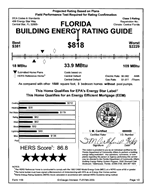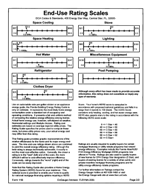
![]()
How is a Building's Energy Efficiency Determined?
In Florida, a building's energy efficiency can only be determined using Florida's Building Energy Efficiency Rating System. Because of the Florida Building Energy Efficiency Ratings Act, this is a matter of law in Florida. The intent of the Act is to create a "yardstick" that serves to "level the playing field" so that the marketplace will have the requisite understanding and confidence to assign economic value to the result of a Rating. Since energy efficiency is largely an invisible attribute, it is virtually impossible to confidently assign market value to it unless the methods and procedures used to determine it are standardized across geographic regions.
The Reference Buildings and the Rating Guide
The Florida Building Energy Efficiency Rating System determines a building's energy efficiency by comparing its projected energy use with the projected energy use of a group of 3 "twin" buildings of the same type, located in the same climate. These "twins" are referred to by the following names and have the following general building envelop and building equipment characteristics:
- Best: A geometric twin of the Rated building that is configured to have the optimum technically achievable efficiency levels. It is configured to have the optimum envelop characteristics and the optimum equipment efficiencies for the climate in which the Rated building is located.
- Worst: A geometric twin of the Rated building that is configured to have no redeeming energy features. It is configured to have the poorest envelop characteristics and the poorest equipment efficiencies that are likely to be found in buildings of the same type in the climate in which the Rated building is located.
- HERS Reference: A geometric twin of the Rated building that is configured to be minimally compliant with the 1992 CABO MEC in accordance with the HERS Council Guidelines and the Florida addenda thereto.
The Rating Guide
 The energy efficiency of a home is measured by comparing it (the Rated building)
with one or more of the above "twin" buildings and, again as a
matter of law, the results are presented on the 2-page Department of Community
Affairs (DCA) Florida Building Energy Rating Guide (DCA Form 11). Page
1 (front side) of the form (at right) is composed of the following major
elements:
The energy efficiency of a home is measured by comparing it (the Rated building)
with one or more of the above "twin" buildings and, again as a
matter of law, the results are presented on the 2-page Department of Community
Affairs (DCA) Florida Building Energy Rating Guide (DCA Form 11). Page
1 (front side) of the form (at right) is composed of the following major
elements:
- Building Rating Scale: Provides a graphic representation of where the Rated building and the HERS Reference building fit on the scale of all similar buildings from Best to Worst. Both the energy cost ($) and energy use (MBtu) of the Best, Worst and Rated buildings are given. Energy cost is determined by multiplying the projected energy uses by the revenue-based price of fuels of the local utilities.
- End-Use Bar Chart: Provides a numerical and graphic breakdown of the basic sources of the energy costs for the Rated building. This chart is used to graphically illustrate which energy end-uses cost the most.
- HERS Score & Stars: Provides the HERS Score and the associated number of stars for the Rated building. This score is derived by direct comparison of the Rated building with the HERS Reference building. Only the heating, cooling and hot water energy uses are considered in the HERS Score and it has no relation to the Best and Worst buildings used to construct the Rating Scale described above. The HERS Score is used to determine eligibility for many incentive programs. For example, a HERS Score of 80 or greater qualifies a home for the national Energy Efficient Mortgage program, and a HERS Score of 86 qualifies a home for EPA's ENERGY STAR Homes program.
- Certification: Provides the State of Florida certification information for the Rater of the building. This segment contains the printed name, signature and state certification number of the individual who conducted the Rating and prepared the reports.
 Page
2 (back side) of the Rating Guide (at right) contains the following additional
information, which describes the Rating in greater detail, and provides advise
on how it should be interpreted.
Page
2 (back side) of the Rating Guide (at right) contains the following additional
information, which describes the Rating in greater detail, and provides advise
on how it should be interpreted.
- End-Use Rating Scales: Provide a graphic representation of the relative energy efficiency of each of the energy end-uses that make up the building's Rating. The values contained on these scales are summed to arrive at the values contained on the Building Rating Scale described above.
- Interpretation Information: Provides basic general information on how the energy efficiency Rating should be interpreted.
All of these elements except the interpretation information are constructed by comparing the Rated building with either the Best and Worst buildings and/or the HERS Reference building.
